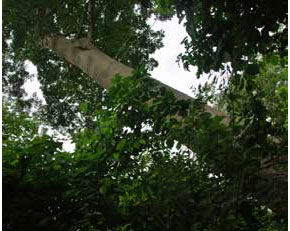
IITA’s forest unit partners with BGCI to address depleting forest resources

Secondary forest growth, IITA forest.
Nigeria’s forest cover is now less than 5% of its original state and far below the recognized target of 25% to mitigate climate change. According to the country’s Biodiversity Strategy and Action Plan, all of its forests will be gone in less than 3 years unless urgent steps are taken to halt and reverse this trend. Botanic Gardens Conservation International (BGCI), funded by the Mohamed bin Zayed Species Conservation Fund (MbZ), has partnered with the IITA Forest Unit in Ibadan to raise awareness of the threats facing Nigeria’s forests and to begin practical conservation of threatened trees by collecting seeds, propagating trees, and contributing training and capacity building for reforestation and forest restoration projects.
Nigeria has one of the highest deforestation rates in the world, with an annual deforestation rate of 3.5%. About 20% of the country was previously covered in what are known as Guineo-Congolean lowland rainforests. Both legal and illegal forestry practices, combined with agriculture, have reduced this by 95%, resulting in hardship for rural communities that then migrate to cities.
A number of trees in these forests, such as mahoganies (Khaya and Entandrophragma spp.), Iroko, and African walnut (Mansonia altissima), are also important to Nigeria’s economy, and at one time African whitewood (Triplochiton scleroxylon), known locally as obeche, contributed 80% to Nigeria’s GDP. These forests also contain 84% of African primates, 68% of African passerine birds, and 66% of African butterfly species, making them important also in the conservation of biodiversity and endangered species.
The first step in setting up the project was compiling a list of 58 threatened tree species, four of which are high priority: Nigerian kola (Cola nigerica), sapele (Entandrophragma cylindricum), afrormosia (Pericopsis elata), and cherry mahogany (Tieghemella heckelii). Only a few of these species are represented in botanic gardens globally and the endemic Nigerian kola, which has no reported collections, is assessed by the IUCN Red List as critically endangered.
Of the 58 species, the Forest Unit has so far collected propagation material from 31 tree species, including surplus seeds from 13 target species, which are now stored in the IITA genebank. When threatened species are successfully propagated, young trees are planted in the IITA Tree Heritage Park. A total of 34 threatened species have been planted so far as an insurance policy against extinction and as a source of propagation material for future reintroductions. The Forest Unit has also conducted propagation trials for 10 target species, and has completed Red List assessments for eight.
The team is still trying to collect propagation material from other species on the list. However, funding for the MbZ project closed on 31 May, and though supplementary funding for certain aspects of the project were awarded by the Australian High Commission Abuja until October 2017, further funding is urgently needed to sustain the conservation of Nigeria’s most threatened trees.
To raise awareness locally, the Forest Unit held a workshop in June to which representatives from the Forestry Research Institute of Nigeria (FRIN), the National Centre for Genetic Resources & Biotechnology (NACGRAB), and the Nigerian Conservation Foundation (NCF) were invited, together with staff of universities, state departments of forestry, and national parks. While maintaining connections with conservation partners, the Unit is now focused on compiling a Manual of Propagation for Nigerian Trees that will be available to download free when the new website is active.
Deni Bown, Head of IITA’s Forest Unit, pointed out the threat of encroachment, clearance, logging, unsustainable collection of non-timber forest products, and illegal timber trading to the country’s forests. She urges everyone to take immediate action to prevent the irreversible decline of hardwoods such as mahogany, afrormosia, and Senegal rosewood (Pterocarpus erinaceus). She also encourages planting native, fast-growing trees instead of exotics such as teak, Gmelina, and eucalyptus normally used in tree planting activities.
Bown also suggests that increased international pressure should be put on the Federal Government to take measures to conserve Nigeria’s forests.
Sources: National Biodiversity Strategy and Action Plan, 2015, and Prioritising and Protecting Nigeria’s Most Threatened Trees, Deni Bown
